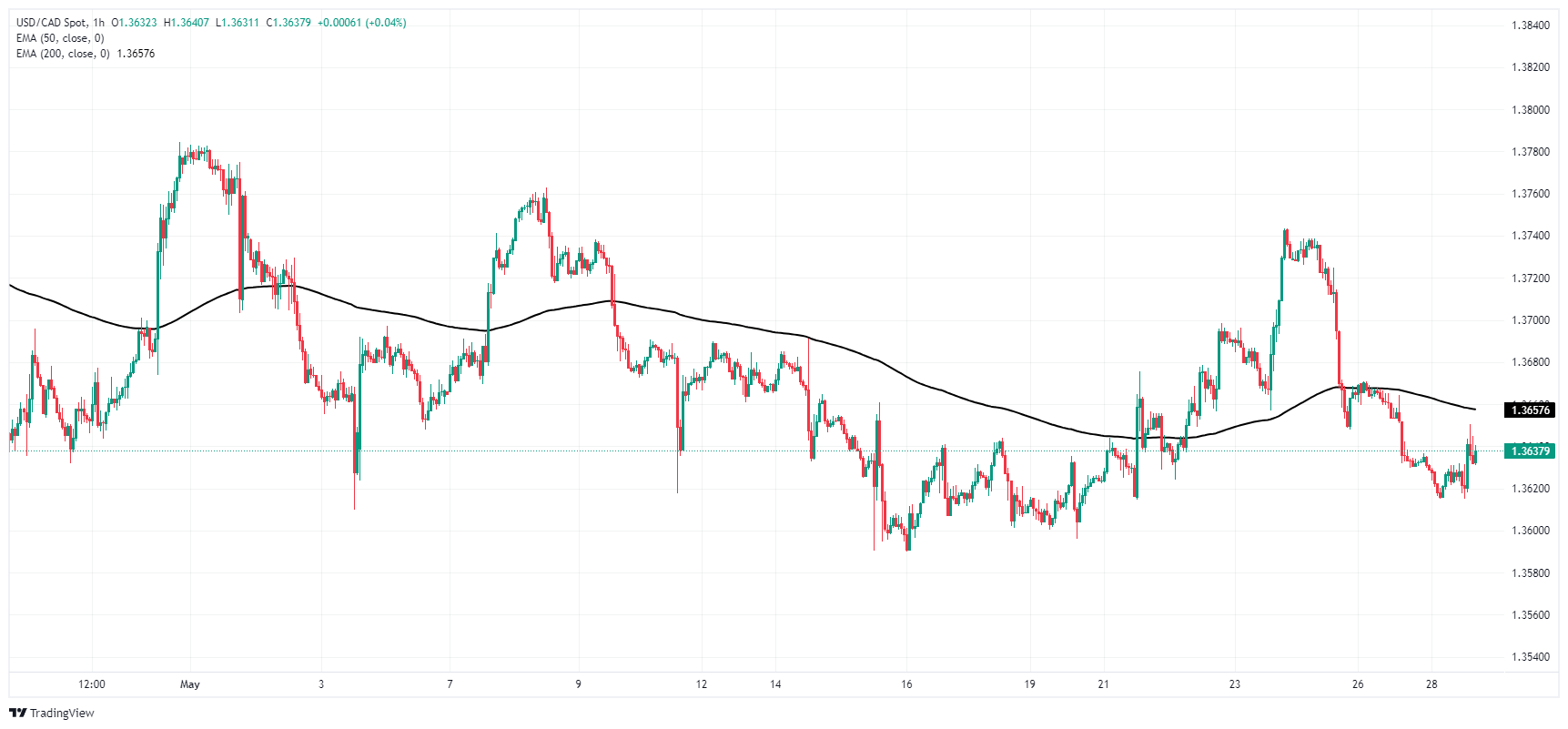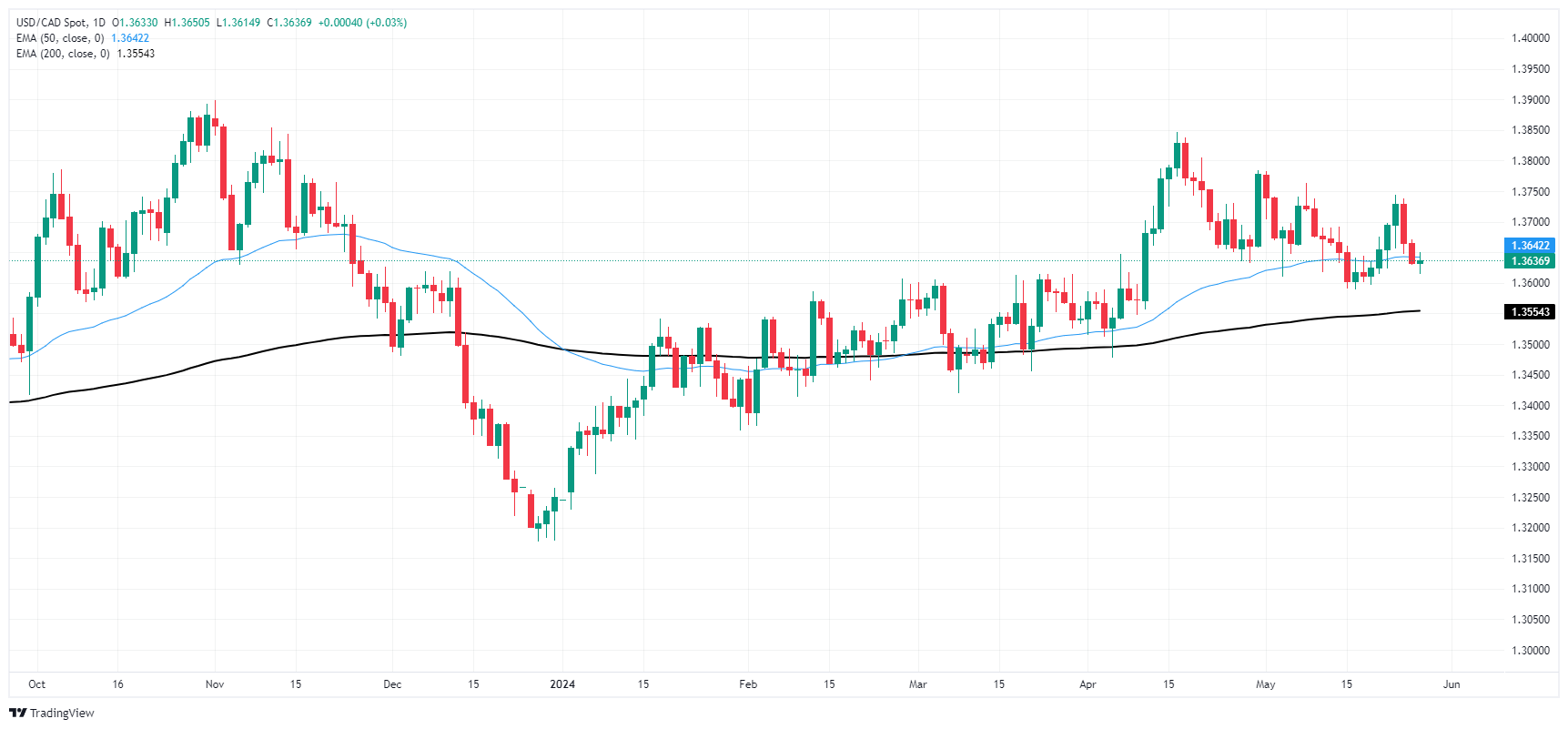- Phân tích
- Tin tức và các công cụ
- Tin tức thị trường
- Canadian Dollar broadly weakens on data-light Tuesday as US markets return to the fold
Canadian Dollar broadly weakens on data-light Tuesday as US markets return to the fold
- US markets return after long weekend, Fedspeak to dominate.
- Canadian Dollar recedes as investors shrug off low-tier CAD data.
- Canada saw an uptick in industrial and raw materials inflation in April.
The Canadian Dollar (CAD) is broadly softer on Tuesday, paring away some of the gains found at the start of the trading week. Fedspeak is set to dominate the headlines as investors buckle down for the long wait to US Gross Domestic Product (GDP) and Personal Consumption Expenditure (PCE) inflation due on Thursday and Friday, respectively.
Canada reported an uptick in industrial inflation in April to little market reaction as investors focus on statements from Federal Reserve (Fed) officials. Broad market sentiment took a hit last week after markets were forced to re-price odds of a September rate cut, and traders are looking for firmer signs of rate cut plans from Fed central planners.
Daily digest market movers: Canadian producer-level inflation ticks higher once again
- Canadian Industrial Product Prices rose 1.5% MoM in April, reversing the forecasted decline to 0.6% from the previous 0.9%.
- Canadian Raw Material Price Index also accelerated in April, rising 5.5% against the previous month’s 4.3% (revised down from 4.7%). Median market forecasts had expected a print of 3.2%.
- Comments from Fed officials continue to dominate the market as investors continue to hope for signs of interest rate cuts despite a firmly cautious lean from policymakers.
- Canadian Current Account slated for Thursday to be overshadowed by US Q1 GDP, while market reactions to Canadian Q1 GDP on Friday will be entirely engulfed by US PCE Price Index inflation.
- Markets are expecting a downturn in US GDP, while US PCE inflation is forecast to hold in-line with previous figures, but rate cut hopes could be tainting the picture.
Canadian Dollar PRICE Today
The table below shows the percentage change of Canadian Dollar (CAD) against listed major currencies today. Canadian Dollar was the strongest against the Japanese Yen.
| USD | EUR | GBP | JPY | CAD | AUD | NZD | CHF | |
|---|---|---|---|---|---|---|---|---|
| USD | -0.14% | -0.05% | 0.05% | 0.01% | -0.10% | -0.09% | -0.31% | |
| EUR | 0.14% | 0.09% | 0.17% | 0.13% | 0.04% | 0.09% | -0.15% | |
| GBP | 0.05% | -0.09% | 0.10% | 0.03% | -0.04% | -0.00% | -0.25% | |
| JPY | -0.05% | -0.17% | -0.10% | -0.03% | -0.13% | -0.08% | -0.31% | |
| CAD | -0.01% | -0.13% | -0.03% | 0.03% | -0.11% | -0.06% | -0.31% | |
| AUD | 0.10% | -0.04% | 0.04% | 0.13% | 0.11% | 0.05% | -0.22% | |
| NZD | 0.09% | -0.09% | 0.00% | 0.08% | 0.06% | -0.05% | -0.25% | |
| CHF | 0.31% | 0.15% | 0.25% | 0.31% | 0.31% | 0.22% | 0.25% |
The heat map shows percentage changes of major currencies against each other. The base currency is picked from the left column, while the quote currency is picked from the top row. For example, if you pick the Canadian Dollar from the left column and move along the horizontal line to the US Dollar, the percentage change displayed in the box will represent CAD (base)/USD (quote).
Technical analysis: Canadian Dollar hits a wall, stumbles back
The Canadian Dollar (CAD) is broadly softer on Tuesday, shedding weight across the board and holding flat against the battered Japanese Yen (JPY) as the day’s strongest pair performance from the CAD. Despite broad-spectrum weakness from the Canadian Dollar, pullbacks remain limited, with the CAD trading within a fifth of a percent against nearly all of its major peers.
USD/CAD rebounded to test 1.3650 after arresting a decline below 1.3620, and the 1.3600 handle is firming into a technical barrier rather than a target for short pressure. The pair is still down 0.8% from last week’s peak just above 1.3740, and daily candlesticks are mired in technical congestion near the 50-day Exponential Moving Average (EMA) at 1.3642.
USD/CAD hourly chart
USD/CAD daily chart
Canadian Dollar FAQs
The key factors driving the Canadian Dollar (CAD) are the level of interest rates set by the Bank of Canada (BoC), the price of Oil, Canada’s largest export, the health of its economy, inflation and the Trade Balance, which is the difference between the value of Canada’s exports versus its imports. Other factors include market sentiment – whether investors are taking on more risky assets (risk-on) or seeking safe-havens (risk-off) – with risk-on being CAD-positive. As its largest trading partner, the health of the US economy is also a key factor influencing the Canadian Dollar.
The Bank of Canada (BoC) has a significant influence on the Canadian Dollar by setting the level of interest rates that banks can lend to one another. This influences the level of interest rates for everyone. The main goal of the BoC is to maintain inflation at 1-3% by adjusting interest rates up or down. Relatively higher interest rates tend to be positive for the CAD. The Bank of Canada can also use quantitative easing and tightening to influence credit conditions, with the former CAD-negative and the latter CAD-positive.
The price of Oil is a key factor impacting the value of the Canadian Dollar. Petroleum is Canada’s biggest export, so Oil price tends to have an immediate impact on the CAD value. Generally, if Oil price rises CAD also goes up, as aggregate demand for the currency increases. The opposite is the case if the price of Oil falls. Higher Oil prices also tend to result in a greater likelihood of a positive Trade Balance, which is also supportive of the CAD.
While inflation had always traditionally been thought of as a negative factor for a currency since it lowers the value of money, the opposite has actually been the case in modern times with the relaxation of cross-border capital controls. Higher inflation tends to lead central banks to put up interest rates which attracts more capital inflows from global investors seeking a lucrative place to keep their money. This increases demand for the local currency, which in Canada’s case is the Canadian Dollar.
Macroeconomic data releases gauge the health of the economy and can have an impact on the Canadian Dollar. Indicators such as GDP, Manufacturing and Services PMIs, employment, and consumer sentiment surveys can all influence the direction of the CAD. A strong economy is good for the Canadian Dollar. Not only does it attract more foreign investment but it may encourage the Bank of Canada to put up interest rates, leading to a stronger currency. If economic data is weak, however, the CAD is likely to fall.
© 2000-2024. Bản quyền Teletrade.
Trang web này được quản lý bởi Teletrade D.J. LLC 2351 LLC 2022 (Euro House, Richmond Hill Road, Kingstown, VC0100, St. Vincent and the Grenadines).
Thông tin trên trang web không phải là cơ sở để đưa ra quyết định đầu tư và chỉ được cung cấp cho mục đích làm quen.
Giao dịch trên thị trường tài chính (đặc biệt là giao dịch sử dụng các công cụ biên) mở ra những cơ hội lớn và tạo điều kiện cho các nhà đầu tư sẵn sàng mạo hiểm để thu lợi nhuận, tuy nhiên nó mang trong mình nguy cơ rủi ro khá cao. Chính vì vậy trước khi tiến hành giao dịch cần phải xem xét mọi mặt vấn đề chấp nhận tiến hành giao dịch cụ thể xét theo quan điểm của nguồn lực tài chính sẵn có và mức độ am hiểu thị trường tài chính.
Sử dụng thông tin: sử dụng toàn bộ hay riêng biệt các dữ liệu trên trang web của công ty TeleTrade như một nguồn cung cấp thông tin nhất định. Việc sử dụng tư liệu từ trang web cần kèm theo liên kết đến trang teletrade.vn. Việc tự động thu thập số liệu cũng như thông tin từ trang web TeleTrade đều không được phép.
Xin vui lòng liên hệ với pr@teletrade.global nếu có câu hỏi.















